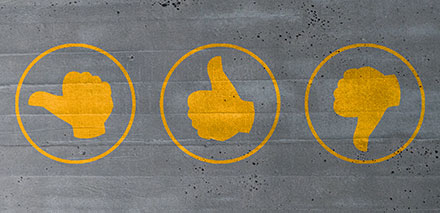A More Creative Solution
A technique to help you define what your customers value and then describe it better.

I’ve always hated the word “solutions” when it comes to describing what a company does. It’s so generic. I mean, every organization from technology to industrial to nonprofit provides some sort of solution to a problem, or they wouldn’t be in business, right?
Well I’ve realized lately that the word solution isn’t the problem. It’s actually a good starting point to figuring out your real value to your customers. Once you’ve uncovered that, then you just have to go one step further and describe it in a less generic, and more powerful way.
Here’s a technique to do both.
Step 1: Define what you provide in terms of what customers value
When asked what you do, it’s easy for most of us to name the widget or service or offerings of our company. But we forget, that’s an internally focused description. And frankly, if you don’t work for the company, who cares? In this exercise we need to flip our description to be about what we do for our customers, which is rarely really about our product or service. It’s about what our product or service does for them. Here’s how.
Start by answering these questions:
What problems do we solve for our customers (constituents, audiences, etc.)?
What pain points do we address or remove?
What can we achieve for our clients that they can’t achieve without us (our product, service)?
What new opportunities or results do they get by working with us?
If you sell trendy clothes it’s not about the clothes. It’s about how you make someone feel when they wear the clothes or maybe how they feel during the process of buying the clothes. You’re selling confidence and a connection to forward-leaning fashion. If you sell computer software, you are probably really selling time-saving results or a sense of security. You’ll notice these examples are all about the emotions someone feels, because emotions drive buying behaviors.
Once you’ve answered all these questions it should become more clear what your real solution is all about, and step 1 is complete.
Step 2: Be more memorable and less generic
Now comes the fun part. Take your solution language and craft statements that are more creative and memorable, and, most importantly, all about the customer. Be sure you don’t use the word solution in them.
Let’s go back to our example of clothing. We decided our solution is that we are selling confidence, up-to-date fashion, and perhaps a sense of pride that comes with being seen as hip and on trend. Great. Let’s play with that using customer-centric language.
Start by defining the problem in a more interesting way:
Tired fashion
A boring look for a boring person
Another sheep at work
Lackluster looks
Dreary clothing
Humdrum outfits lead to humdrum attitudes
A nonevent in look and in action
Mind-numbing outlook
Monotonous
Then move on to our solution of confidence and pride described in a fresh way:
Be a rock star
You own it
Show your inner wolf
Look like the kingpin that you are
Be a trail blazer
Feel assured
Be seen as chic
Look popular
Be all the rage
Get hip
Show you know what’s next in fashion
Go places when you look like you are going places
Step 3: Put it all together
Once you have a strong list, work on some phrases that are customer-focused. Put the problem upfront and the payoff of your solution in the back. Here are a couple of examples.
When asked what you do:
We bring out your inner rock star with outer awesomeness.
We eradicate mind-numbing clothes with trail-blazing fashion.
We help you look good so you can be your great self.
We believe monotonous clothes are out. And you deserve to be in.
Tired of tired fashion? Our customers look like they are going places, because they are.
You get the point. The goal is to be clear about what you do, but not generic. Because when you evoke emotions that are tied to your brand, you communicate the value customers get from working with you, and you make their outcomes crystal clear, you will have a real solution customers will remember.
Tap into All of Your Customer’s Needs
Make sure your brand meets both functional and emotional needs for your customers making a purchase decision.
A Better Way to Sell
Smarter customers are changing the way we sell.
Idea Evaluation
How do you decide which ideas to implement and which to toss aside?



